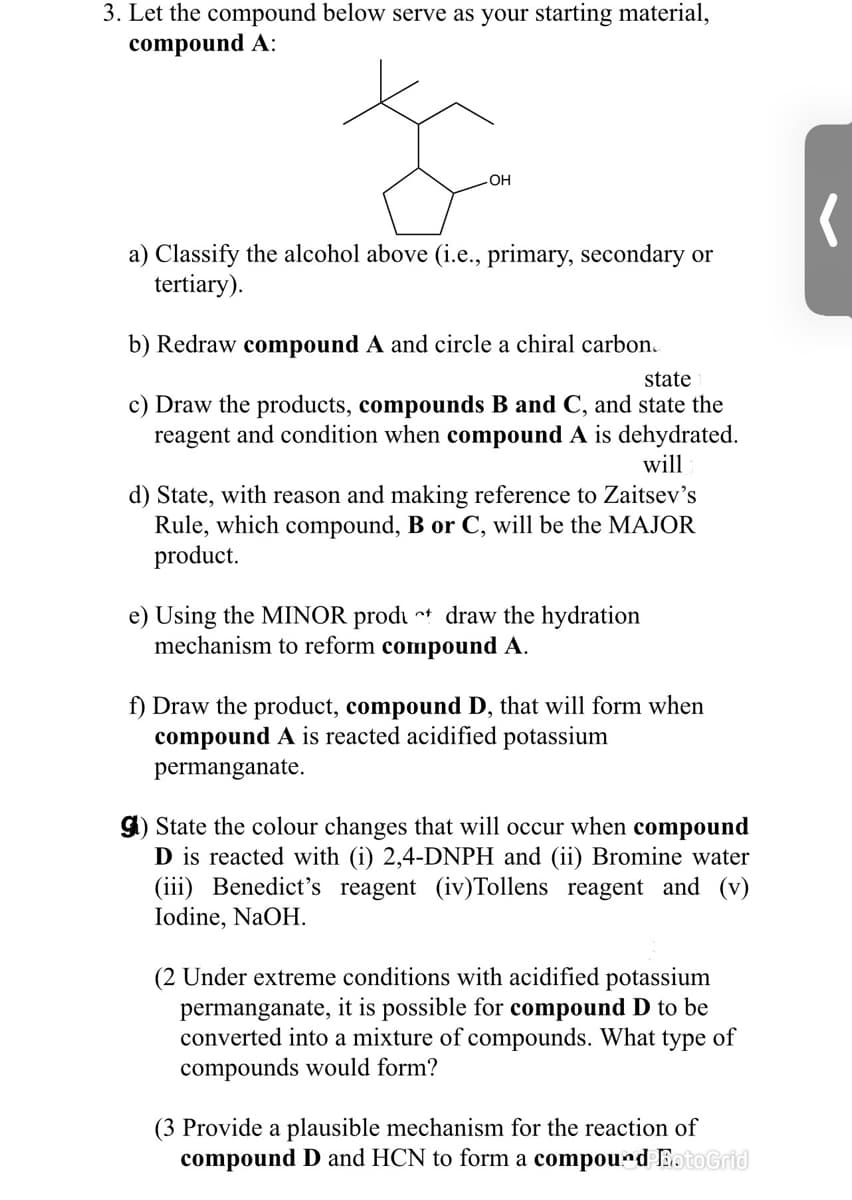(2 Under extreme conditions with acidified potassium permanganate, it is possible for compound D to be converted into a mixture of compounds. What type of compounds would form? (3 Provide a plausible mechanism for the reaction of compound D and HCN to form a compourd EotoGrid
(2 Under extreme conditions with acidified potassium permanganate, it is possible for compound D to be converted into a mixture of compounds. What type of compounds would form? (3 Provide a plausible mechanism for the reaction of compound D and HCN to form a compourd EotoGrid
Organic Chemistry: A Guided Inquiry
2nd Edition
ISBN:9780618974122
Author:Andrei Straumanis
Publisher:Andrei Straumanis
Chapter14: Elimination
Section: Chapter Questions
Problem 37E
Related questions
Question
Please answer Q 2&3 at the bottom not the top.

Transcribed Image Text:3. Let the compound below serve as your starting material,
compound A:
OH
a) Classify the alcohol above (i.e., primary, secondary or
tertiary).
b) Redraw compound A and circle a chiral carbon.
state
c) Draw the products, compounds B and C, and state the
reagent and condition when compound A is dehydrated.
will
d) State, with reason and making reference to Zaitsev's
Rule, which compound, B or C, will be the MAJOR
product.
e) Using the MINOR produ t draw the hydration
mechanism to reform compound A.
f) Draw the product, compound D, that will form when
compound A is reacted acidified potassium
permanganate.
gi) State the colour changes that will occur when compound
D is reacted with (i) 2,4-DNPH and (ii) Bromine water
(iii) Benedict's reagent (iv)Tollens reagent and (v)
Iodine, NaOH.
(2 Under extreme conditions with acidified potassium
permanganate, it is possible for compound D to be
converted into a mixture of compounds. What type of
compounds would form?
(3 Provide a plausible mechanism for the reaction of
compound D and HCN to form a compourd BotoGrid
Expert Solution
This question has been solved!
Explore an expertly crafted, step-by-step solution for a thorough understanding of key concepts.
Step by step
Solved in 2 steps with 2 images

Knowledge Booster
Learn more about
Need a deep-dive on the concept behind this application? Look no further. Learn more about this topic, chemistry and related others by exploring similar questions and additional content below.Recommended textbooks for you

Organic Chemistry: A Guided Inquiry
Chemistry
ISBN:
9780618974122
Author:
Andrei Straumanis
Publisher:
Cengage Learning

Organic Chemistry
Chemistry
ISBN:
9781305580350
Author:
William H. Brown, Brent L. Iverson, Eric Anslyn, Christopher S. Foote
Publisher:
Cengage Learning

Organic Chemistry: A Guided Inquiry
Chemistry
ISBN:
9780618974122
Author:
Andrei Straumanis
Publisher:
Cengage Learning

Organic Chemistry
Chemistry
ISBN:
9781305580350
Author:
William H. Brown, Brent L. Iverson, Eric Anslyn, Christopher S. Foote
Publisher:
Cengage Learning